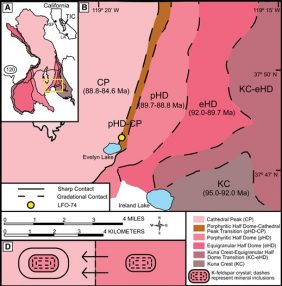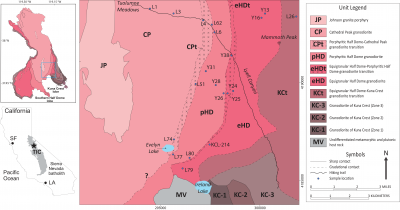Background

The location of the megacryst labeled as LFO-74 is detailed in the following contexts:
(A) The inset map exhibits the Tuolumne Intrusive Complex (TIC) and its positioning within California, USA, with references to San Francisco (SF) and Los Angeles (LA).
(B) LFO-74’s specific location is highlighted within the southeastern lobe of the TIC, where gradual contacts and distinct hybrid units separate the main TIC units. This map adaptation derives from Huber et al. (1989), later refined by Louis Oppenheim in May 2019.
(D) A conceptual representation outlining the K-feldspar recycling hypothesis. This suggests that inclusion-rich K-feldspars observed in the porphyritic Half Dome (pHD) are recycled into the Cathedral Peak (CP) unit.

The geological map here depicts the field area encompassing the transition from the Kuna Crest (KC) granodiorite lobe to the primary intrusion of the Tuolumne intrusive complex (TIC). It outlines all key TIC units, transitional interunit boundaries, and the specific locations where samples were collected for this investigation, indicated by blue dots. This information is drawn, in part, from Bateman et al. (1983). The top inset map indicates the study area’s position within the TIC, sourced and adapted from Memeti et al. (2014). The bottom inset map illustrates the TIC’s location within the Sierra Nevada batholith and California, featuring reference points such as San Francisco and Los Angeles.